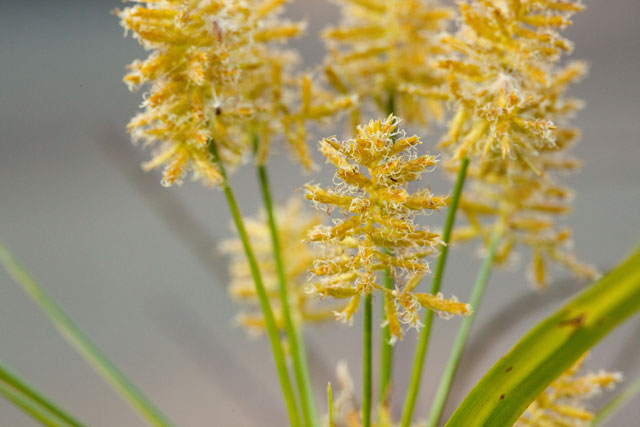

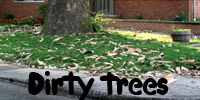
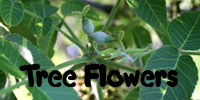

(Additional content at flickr Photostream and YouTube Channel)
If you have botany questions or comments please email BobK . Thanks!
Waldo, Marion County, Ohio
September 10, 2009.
Where's
Waldo? It's a little
town in southern Marion County, Ohio, right alongside Rte. 23, midway
between Delaware and Marion. It's rural, and there are parts of the
Delaware Wildlife Area there. There's some nice wild land to walk
around on. I went looking for mosses, but didn't see very many
of
them. There were, however, some interesting wildflowers. One of them is
the loveliest of common goldenrods. This is gray, or old-field
goldenrod, Solidago
nemoralis (family
Asteraceae). It is an especially low-growing species, with a fidelity
to dry open areas. It has a distinctive wand-like appearance, short
obovate leaves, and short gray hairs (not visible in the photo below).
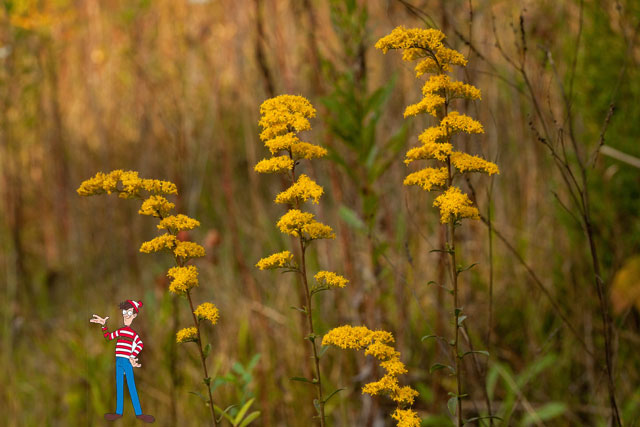
Gray goldenrod. Waldo, Marion County, Ohio.

Gray goldenrod. Waldo, Marion County, Ohio.
Fruiting earlier than other milkweeds, this swamp milkweed, Asclepias incarnata (family Asclepiadaceae) has follicles that have split open and are releasing long-haired seeds that are wind-dispersed.
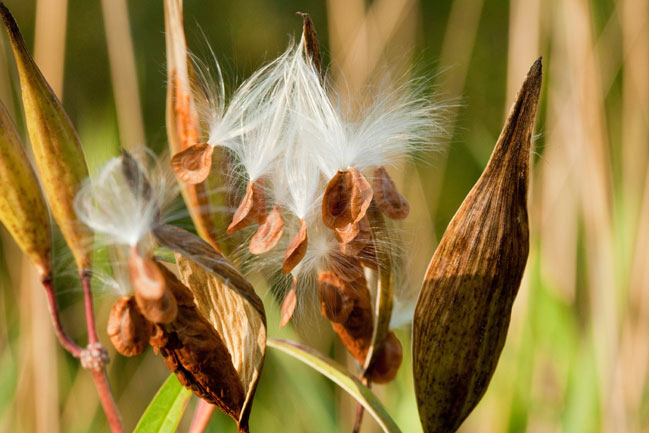
Swamp milkweed seeds are wind-dispersed. Sept. 10, 2009. Marion County, Ohio.
A
noxious weedy member of a
genus that includes some lovely prairie, glade and meadow wildflowers
is Chinese lespedeza, Lespedeza
cuneata (family Fabaceae).
This plant has a distinctive
appearance, consisting of sprays of wiry wand-like flowering
stems with flowers and leaves hugging the stems along most of their
length. An Asian native, It occurs along roadsides, prairies and
pastures. Thriving in poor soil, it can be seen in reclamation areas.
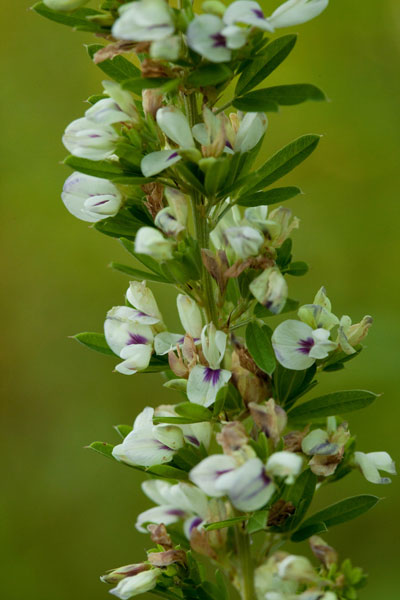
Chinese lepedeza has a wand-like inflorescence. Sept. 10, 2009. Marion County, Ohio.

Chinese lepedeza has a wand-like inflorescence. Sept. 10, 2009. Marion County, Ohio.
According
to information in
their excellent collection of synopses of the nastiest nasties of the
plant world, Kaufman and Kaufman (2007), in "Invasive Plants"
(Stackpole Books) explain that the species was introduced in Richmond
Virginia in 1899. It has been, and still is, planted for forage and
erosion control, roadside stabilization, and as ground cover for
nesting birds. Chinese lepedeza blossoms are pea-like, typical
Fabaceae, with papilionaceous (butterfly-like) bilateral symmetry:
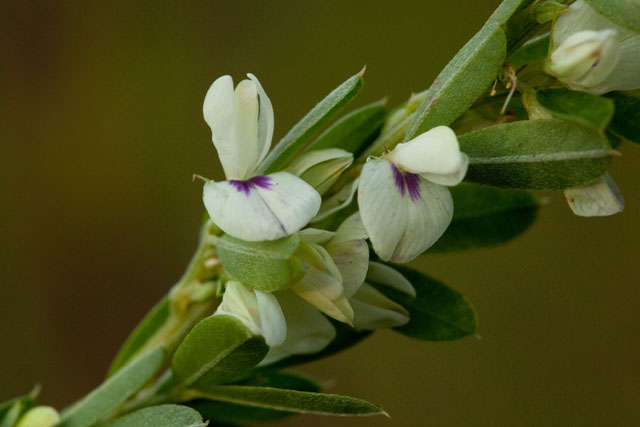
Chinese lespedeza. September 10, 2009. Marion County, Ohio.

Chinese lespedeza. September 10, 2009. Marion County, Ohio.
Some Late Summer Insects
Nashville, Miami County, Ohio
September 6 2009
Again, it was a great pleasure for us "city mice" to visit our "country mice" friends at their lovely 15-acre paradise in rural southeastern Ohio. Having recently obtained Lang Elliot and Will Hershberger's awesome "The Songs of Insects" book, a goal was to snap some pics of night-time singers. A general level of entomological interest was raised, resulting in photos of representatives of six orders: Lepidoptera, Homoptera, Orthoptera, Dermaptera, Diptera, and Hemiptera.
I chased a black swallowtail nectaring on red clover. The butterfly is very fond of the clover, so you could say it loves clover. Several times I had to move the butterfly in order to get a better picture of the clover. Being near Wright-Patterson Air Force Base, there was a lot of air traffic, including a helicopter piloted by a man named Rover. My attempts to relocate the butterfly with an affinity for Trifolium attracted some scrutiny from the pilot, so I ducked under a tree for cover. To monitor my activities from the air, the flight dispatcher's instruction to the chopper pilot was simple: "Hover over clover-lover mover cover, Rover!"
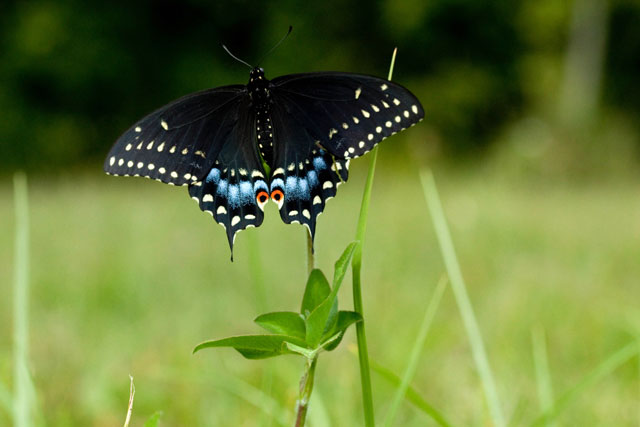
Black swallowtail sips nectar from clover. September 6, 2009. Nashville, Ohio.
Night
fell, and orthopterans
began singing merrily. One of these was a jumping bush-cricket, Orocharis saltator,
on a leaf about
5 feet up a tree. Will and Lang tell us this cricket is "often heard
but seldom seen...a common inhabitant of rural and urban backyards."
They cite its flattened or compressed appearance as distinctive. The
call is a "clear brief trill or chirp, repeated at the rate of one or
two per second," at a frequency of about 5 kHz.
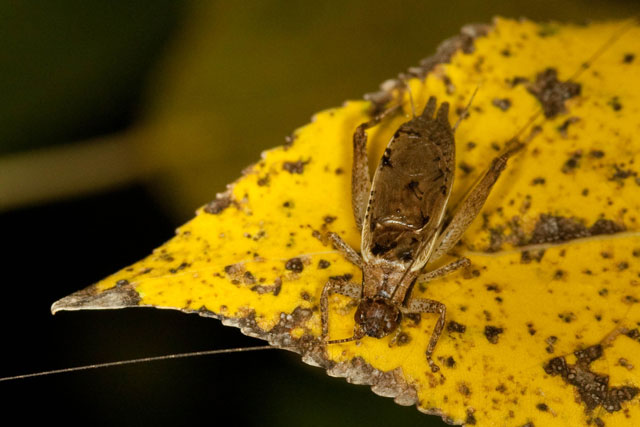
Jumping bush cricket. September 6, 2009. Nashville, Miami County, Ohio.

Jumping bush cricket. September 6, 2009. Nashville, Miami County, Ohio.
At
the base of the tree was
evidence of the emergence from the ground, earlier in the summer, of a
daytime songster. This is a cicada, one of several possible species in
the genus Tibicen
(order
Homoptera). These are termed "annual" cicadas, as some adults emerge
every year (and to distinguish them from the 13-year and 17-year
"periodical" ones). Note however, that even though annual adults emerge
every year, an individual annual cicada's life cycle includes several
years below the ground.
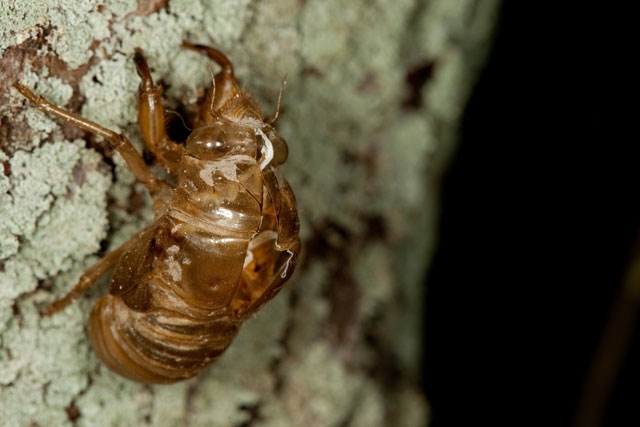
Annual cicada exoskeleton at base of tree. September 6, 2009. Miami County, Ohio.

Annual cicada exoskeleton at base of tree. September 6, 2009. Miami County, Ohio.
Tree
crickets are lovely
animals, surprisingly delicate in appearance, with light bodies and
transparent wings. They sing at night. About a dozen species occur in
the eastern United States, and several look quite alike. Seen under a
leaf of a tree a at the edge of a woodlot, here is what seems to be a
narrow-winged tree cricket, Oecanthus
niveus, a species that Elliot and Hershberger tell us is
"light green
in color with a prominent reddish cap ...a handsome species that often
sports pale blue eyes." This seems to be a match. The song is "a mellow
trill of variable length, usually lasting about two to ten seconds."
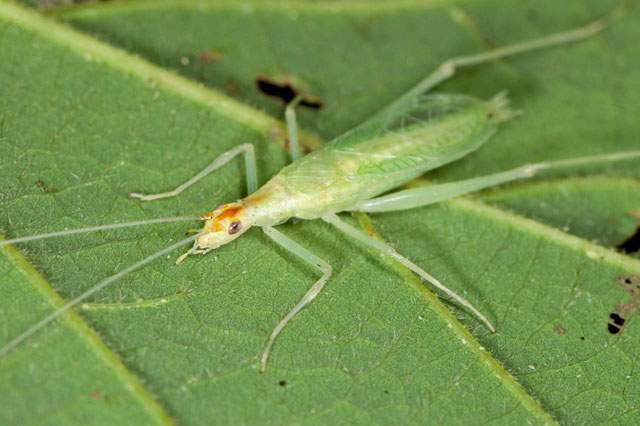
Narrow-winged tree cricket. September 6, 2009. Miami County, Ohio.

Narrow-winged tree cricket. September 6, 2009. Miami County, Ohio.
About
10 feet up a cottonwood
tree (a ladder helped here) a tree cricket merrily sang a loud long
continuous call. I didn't get a good picture of that one, but while
hunting for it did see a creepy-looking earwig (Order
Dermaptera).
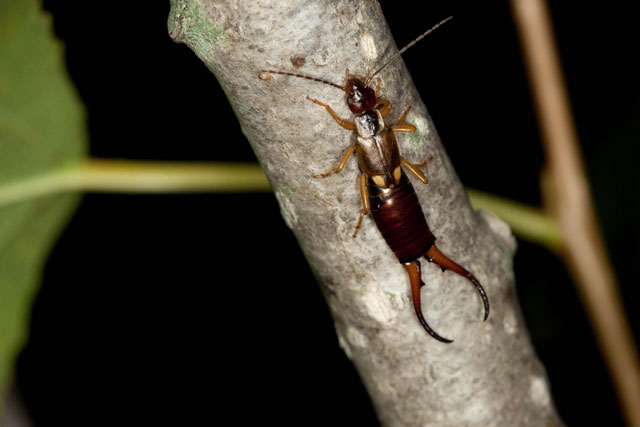
Earwig acting like a tree-cricket. September 6, 2009. Miami County, Ohio.
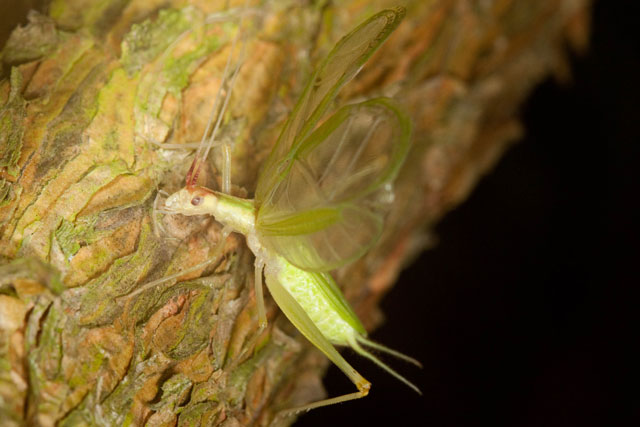
Broad-winged tree cricket. September 6, 2009. Miami County, Ohio.

Earwig acting like a tree-cricket. September 6, 2009. Miami County, Ohio.
A
row of northern white
cedars separates our friends' property from their neighbors. Here, at
eye-level (without the ladder), a tree-cricket songster allowed close
approach while singing. The wings are held erect over the body. The
song matched that of the broad-winged tree cricket, Oecanthus latipennis,
described as:
"Perhaps the loudest of the tree crickets. Males can be heard from two
hundred feet away or more. Songs are pure-toned continuous trills that
are rarely interrupted, with a main frequency of about 3 kHz. and a
pulse rate of about 25 per second."
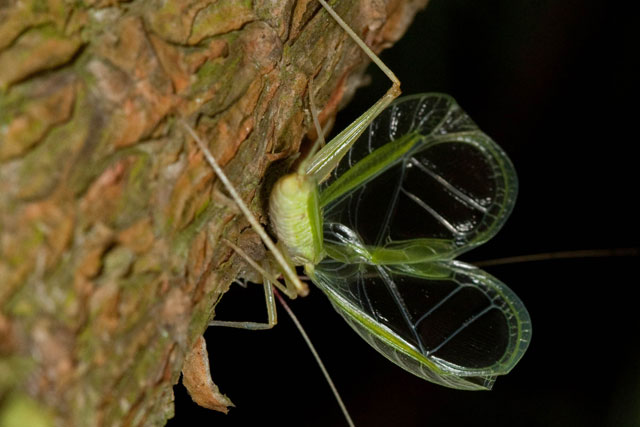
Broad-winged tree cricket. September 6, 2009.

Broad-winged tree cricket. September 6, 2009.
Some
other features that seem
to conform to latipennis are
the "elegant wide wings" and reddish accents not only on the head (seen
on the narrow-winged) but also extending up the base of the antennae.

Broad-winged tree cricket. September 6, 2009. Miami County, Ohio.
The
next day a crane fly
landed on the screen door. Here's what it looked like. Flies are in the
order Diptera, an appropriate and descriptive name because, unlike
other winged insects that have 2 pairs of them, for a total of two
times two equals four wings, flies only have two one pair, i.e., two
wings. The hind wings are reduced, formed into knobby balancing organs
called "halteres," visible in the photo below.
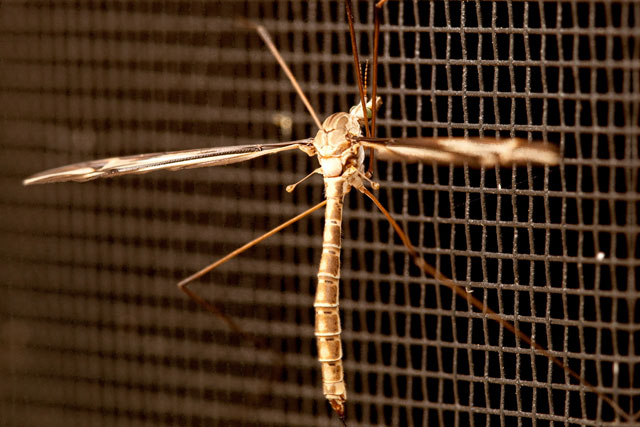
Crane fly on screen. September 6, 2009.

Crane fly on screen. September 6, 2009.
And
a late-summer walk in the
garden to pick some tomatoes, the asparagus plants have berries on
them. And on one of the berries, a stink bug (Order Hemiptera).
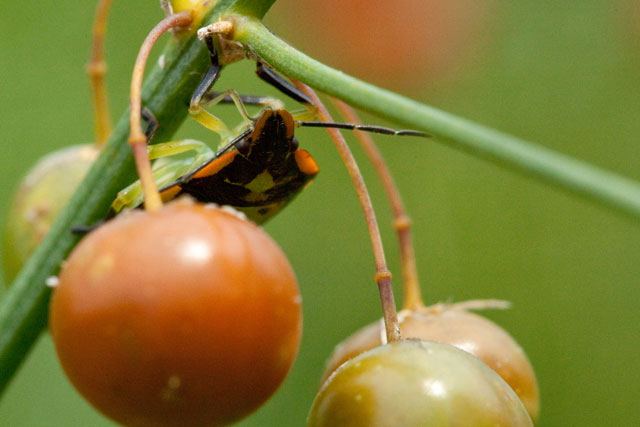
Stink bug on asparagus berry. Miami County, Ohio. September 6, 2009.

Stink bug on asparagus berry. Miami County, Ohio. September 6, 2009.
A Botanical Wilderness Area (of sorts)
September 3, 2009, Columbus Ohio
It's inspirational to travel to places where natural processes unfold without the interfering hand of man. Today I trekked to one of those sacred areas, an undisturbed island of spontaneously arising vegetation along North High Street in Columbus, Ohio. The site is near a very terrific camera store with great deals, smart friendly salespeople, and wooden floors that squeak: Midwest Photo Exchange.

A wilderness park in Columbus, Ohio. September 3, 2009.
Travelers
who voyage to this
exotic location may encouner a mysterious
black flower on a vine that, according to
legend, sometimes grows so thickly it can tangle up a dog!
"Dog-strangling vine," better known as black swallow-wort, Vincetoxicum nigrum
(in the milkweed family, Asclepiadaceae), is a noxious weed native to
Europe.
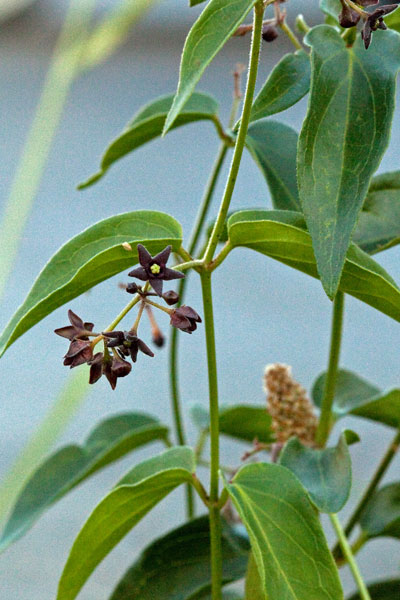
Black swallow-wort. September 3, 2009.

Black swallow-wort. September 3, 2009.
The
swallow-wort flower is dark purple, almost black. Structurally, it is
similar to
milkweeds, having a columnar extension of fused portions of
the stamens extending upwards termed the "corona," and pollen
that is adherent into waxy masses called "pollinia."
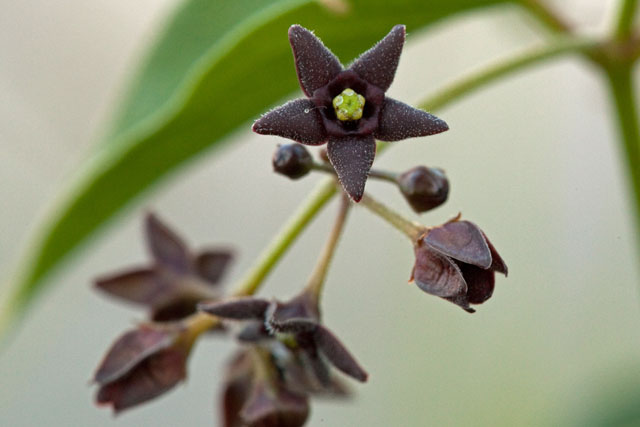

Swallow-wort
blossom. Septtember 3, 2009. Columbus, Ohio.
Several wind-pollinated monocots grow side-by-side in this botanical paradise. Prominent among them is an unidentified species of foxtail, an annual grass in the genus Setaria (family Poaceae). One type of millet (millets are various one-seeded grasses) is a horticultural derivative of the Eurasion Setaria viridis, one of a few species that occur in Ohio.
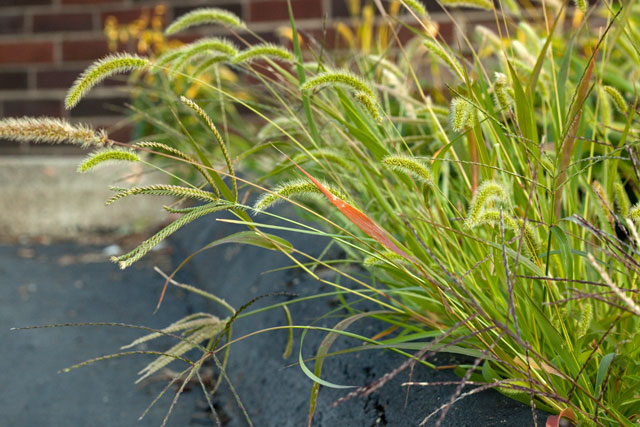
Foxtail and other grasses. September 3, 2009. Columbus, Ohio.
Some of foxtail's associates here are also annual grasses. Goose grass (Eleusine indica) is one, an old world native. Its genus commemorates Eleusis, a town near Athens, where ancients worshipped the harvest goddess Demeter in a cult-like manner that offered hope for life after death.

Goose grass. September 3, 2009. Columbus, Ohio.
With
its finger-like secondary infloresence, Eleusine
is often confused with crabgrass (Digitaria),
but the resemblance is superficial. The genera are in different tribes
within the famly Poaceae, so there are many technical differences
separating them. For example, within the tiny true infloresence called
the
"spikelet," Eleusine
has 3-5 flowers, whereas Digitaria
spikelets are one-flowered. Taken from too far away to see
that,
or to identify what species it is, here's a picture of
crabgrass
anyhow.
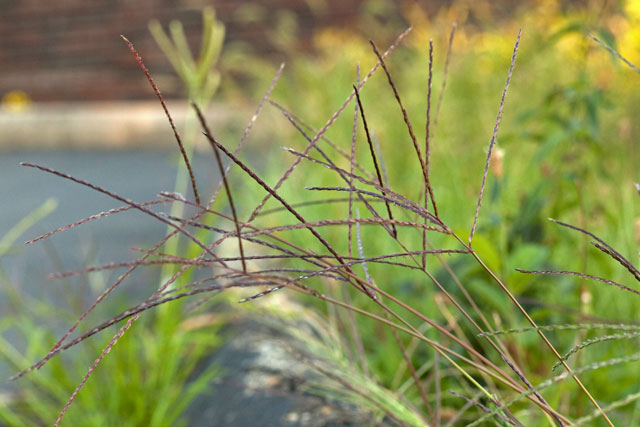
Crabgrass has flower clusters (spikelets) arranged in fingerlike racemes.
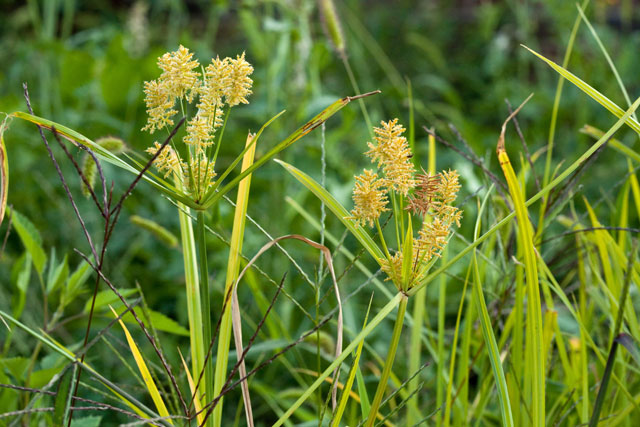
Umbrella-sedge (Cyperus) in Columbus, Ohio. September3, 2009.
These sedges produce each tiny flower singly in the axil of a leaf-like scale. The scales are in two rows along short stems that are arranged together in head-like clusters, and then the clusters themselves are situated atop long stems. The end result is vaguely umbrella-like. The species have perfect (hemaphroditic) flowers, but today this one seems to be displaying only the pistillate (female) part. Note (MOUSEOVER) the elongate corn-silk-like styles that catch pollen drifting in the breeze.

Crabgrass has flower clusters (spikelets) arranged in fingerlike racemes.
An
unidentified species of umbrella-sedge, genus Cyperus
(family Cyperaceae) is in bloom. The stems of a huge Egyptian species
of Cyperus, C.
papyrus was used to make an
early version of the internet, the paper-like product papyrus. The
inner portions of the stem were cut into stripes, two layers were made
at right angles by laying the strips lengthwise with the edges
overlapping, and the layers were flattened, dried, and polished with a
stone or shell. The plant is still used by Egyptian people living
near swamps, to make nets, baskets, mats and the
like.

Umbrella-sedge (Cyperus) in Columbus, Ohio. September3, 2009.
These sedges produce each tiny flower singly in the axil of a leaf-like scale. The scales are in two rows along short stems that are arranged together in head-like clusters, and then the clusters themselves are situated atop long stems. The end result is vaguely umbrella-like. The species have perfect (hemaphroditic) flowers, but today this one seems to be displaying only the pistillate (female) part. Note (MOUSEOVER) the elongate corn-silk-like styles that catch pollen drifting in the breeze.
MOUSEOVER
the IMAGE to see ZOOM-CROP of STYLES
Alongside the foxtail, we see common groundsel, Senecio vulgaris. This is a rayless composite, i.e., a member of the Asteraceae lacking the petal-like peripheral flowers typically found on the flower heads. The two yellow-tipped heads in the center foreground are in full flower. In the background are dandelion-like fruiting heads of common grounsel.
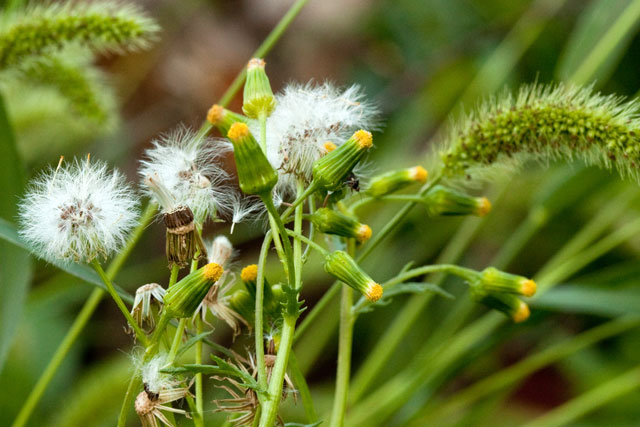
Common groundsel in full bloom. September 3, 2009. Columbus, Ohio.
Umbrella
sedge flowers. September 3, 2009. Columbus, Ohio.
Alongside the foxtail, we see common groundsel, Senecio vulgaris. This is a rayless composite, i.e., a member of the Asteraceae lacking the petal-like peripheral flowers typically found on the flower heads. The two yellow-tipped heads in the center foreground are in full flower. In the background are dandelion-like fruiting heads of common grounsel.

Common groundsel in full bloom. September 3, 2009. Columbus, Ohio.
Amaranth,
or pigweed (any of various members of the genus Amaranthus),
is a wind-pollinated weed in the goosefoot family, Chenopodiaceae. In
many places, expecially Africa and Indonesia, amaranths
are cultivated for their grain-like seeds
and as a nutritious leafy vegetable.
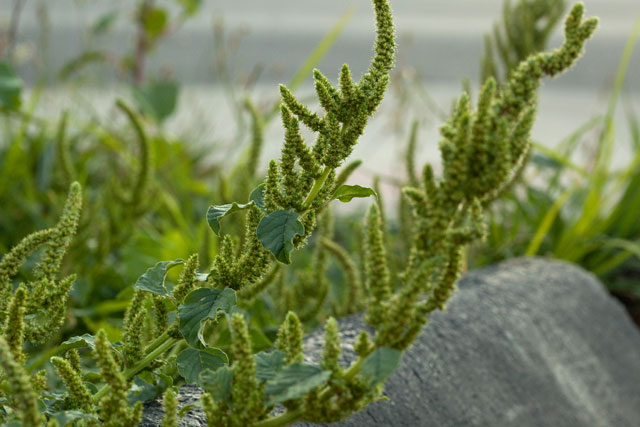
Pigweed (Amaranthus sp.) in Columbus, Ohio. Sepember 3, 2009.

Pigweed (Amaranthus sp.) in Columbus, Ohio. Sepember 3, 2009.
Pokeweed
(Phytolacca
americana, family
Phytolacaceae) is a native perennial herb. It was a favorite food of
the passenger pigeon.
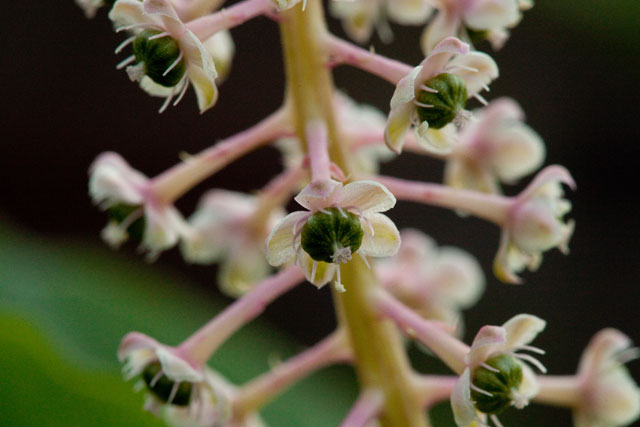
Pokeweed flowers. September 3, 2009. Columbus, Ohio.

Pokeweed flowers. September 3, 2009. Columbus, Ohio.
Some wildflowers are in fruit. One of these is Hibiscus trionum, the short-lived blooms of which are the basis of its common name, "flower of an hour." In the photo below, we don't see the fruit per se, but the expanded globe-like sepals (calyx) that surrounds a five-parted dry capsule.
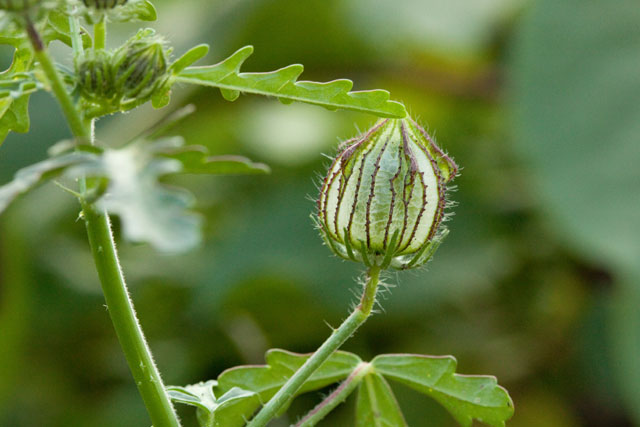
Flower of an hour (Hibiscus trionum) in Columbus, Ohio. Sept., 3, 2009.
A succulent ground-hugging herb is also in fruit. This is purslane (Portulaca oleracea, family Portulacaceae). Purslane has an unusual fruit type, a circumsessile capsule called a "pyxis," that splits along an equator-like seam around its midsection.

The purslane fruit is a capsule that splits all around its middle.
September 3, 2009. Columbus, Ohio.


